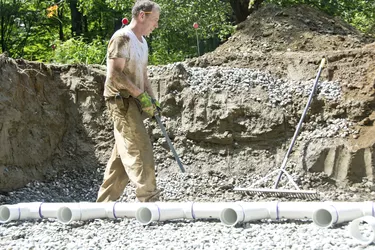
A septic system is more than just a tank connected to a building's sewer lines. Rather, it pumps water through a series of pipes beyond the septic tank, expelling nonpotable water into an area designed to distribute wastewater into the topsoil. This area, known as a leach field, leach pit or waste field, is essential to the proper function of a home's septic system. Leach fields may become damaged in a number of ways, making it necessary to buy a replacement.
Leach Field Replacement Costs
Video of the Day
Two variables determine the cost of replacing a leach field: its size and the presence of contaminated topsoil. If the pipes that deliver gray water -- the nonpotable water flushed from a septic tank -- to the leach field are merely cracked, you need only replace them. Budget about $5,000 for this fix. Costs are considerably higher if sewage has leaked through the septic system and contaminated the soil below the leach pit. In this scenario, you must excavate the contaminated soil and build a new a leach pit, which can cost up to $10,000.
Video of the Day
Abandoning Damaged Leach Fields
In certain instances it may be more cost-effective to abandon the damaged leach field and install a new field. For this option, you need to own enough land to create another suitable leach field. On the upside, you eliminate the costs of excavating the failed or contaminated field. In cases of heavy contamination, you may need to clean up a damaged leach field even when you plan on abandoning the failed system.
Estimating Labor Costs
Because each home's leach field and septic system is different, pricing a leach field replacement is done on a case-by-case basis. As a ballpark, a backhoe operator can excavate about 9.5 linear feet of soil per hour to dig a new leach pit, while a typical installer can install about 12 feet of leach line per hour. Labor costs vary among locations.
Septic Tank Maintenance
Pumping your tank periodically to remove nonbiodegradable materials such as cooking oils, vegetable peelings and plastics flushed into the tank keeps the system healthy. The frequency at which you must pump your tank depends upon the number of people living in the home and the size of the tank. Each 500 gallons of capacity typically provides about five years per single user of the home between each pumping. Using a garbage disposal or daily use of antibacterial soaps may reduce the amount of time between pumping a septic tank, as septic systems rely on bacteria to decompose waste matter in their tank.